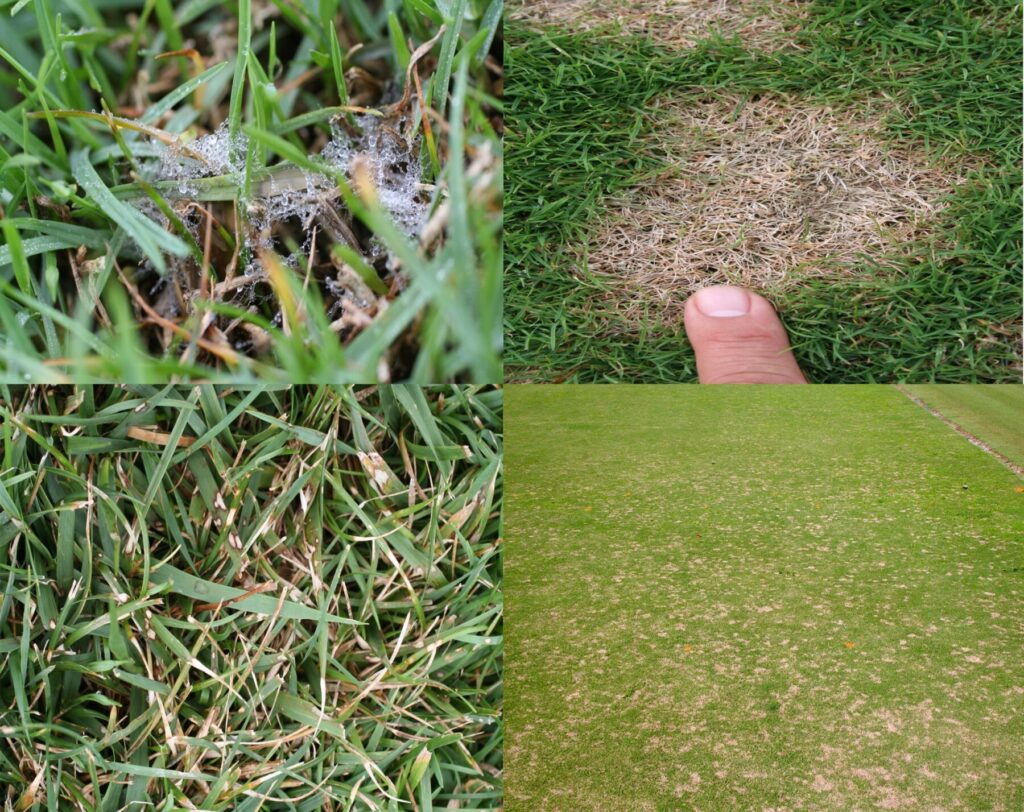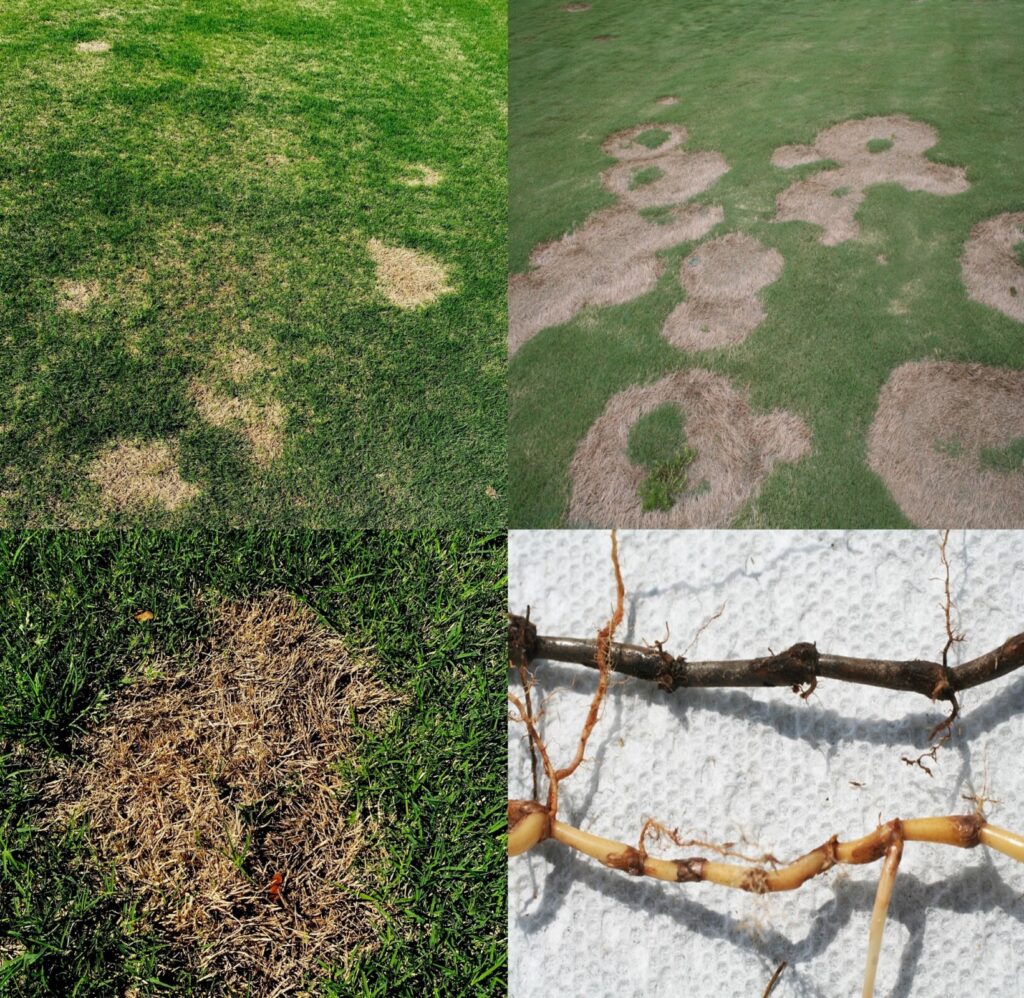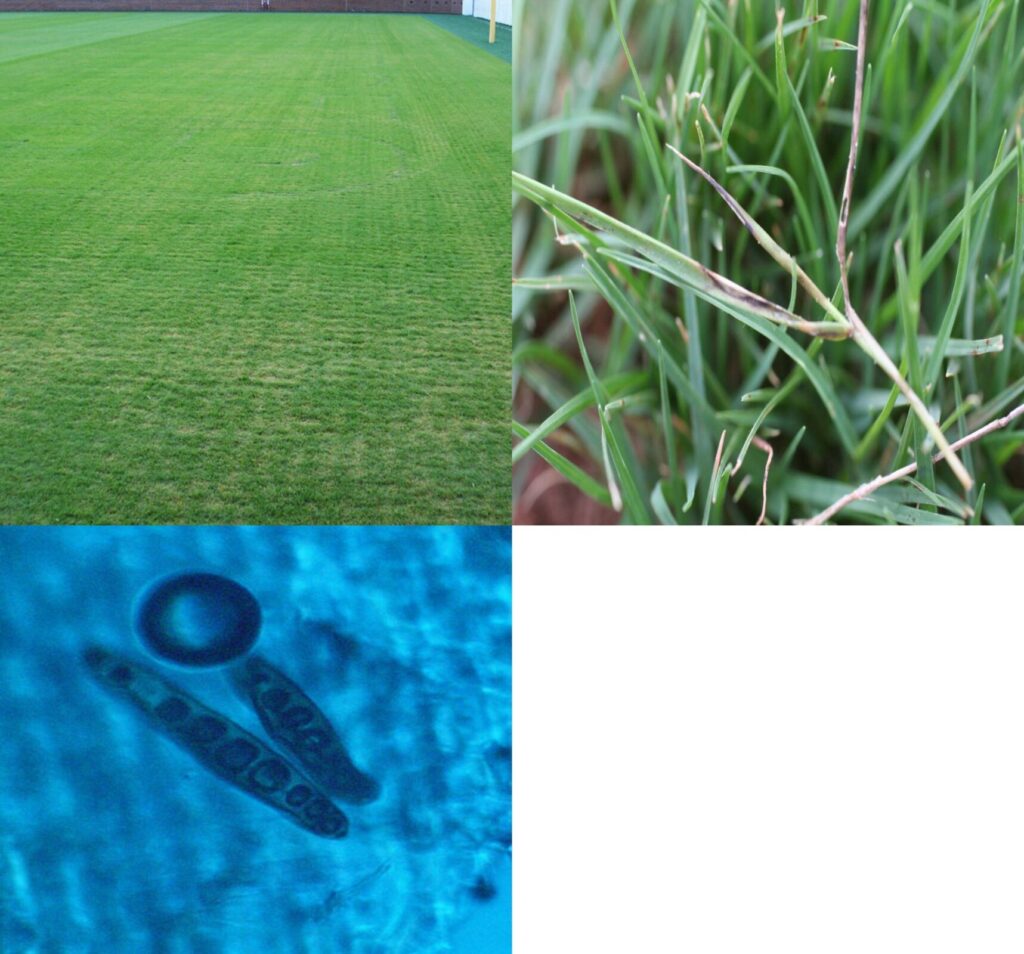Dollar Spot is Active. The dollar spot fungus (Clarireedia sp formerly Sclerotinia homoeocarpa) is now active this 2025 spring. We have seen active infections in bermudagrass and seashore paspalum in our UGA Griffin campus research plots as well as several bermdagrass lawns in the area. Dollar spot can produce infections on warm season grass as soon as they start to green up. Excessive moisture on turfgrass foliage and overcast humid days will promote dollar spot epidemics. Excessive thatch layers and compacted soil stresses is important at this time of the year. Monitoring fertility is an important first step to controlling dollar spot. More on dollar spot can be found at https://secure.caes.uga.edu/extension/publications/files/pdf/C%201091_3.PDF

Chemical control for practitioners: A variety of fungicides are available to professional turfgrass managers for dollar spot control including fungicides containing benzimidazoles, demethylation inhibitors (DMI), carboximides, dicarboximides, dithiocarbamates, nitriles and dinitro-aniline. Several biological fungicides are now labeled for dollar spot control. For a complete and updated list of fungicides available for dollar spot, visit http://extension.uga.edu/publications/detail.cfm?number=SB28
Rhizoctonia Large Patch is here. Initial infections of Rhizoctonia were observed this week at the UGA Griffin campus research plots as well as in recent samples submitted to the Plant Pathology Plant Disease Diagnostic lab. Large patch is caused by the soilborne fungus Rhizoctonia solani AG 2-2 LP. The disease can infect all species of warm season turfgrasses, including St. Augustinegrass, zoysiagrass, centipede and bermudagrass. The disease is apparent during the spring and fall, when warm-season turfgrasses are entering or exiting their period of winter dormancy. R. solani occurs whenever the temperature of the thatch layer is between 50ºF (10ºC) and 70ºF (21ºC), and continuous moisture is available for at least 48 hours. Excessive moisture levels in the soil, thatch, and lower turf canopy encourage large patch development. Factors such as poor drainage, shade, restricted air movement, or excessive irrigation increase the severity of this disease. Rhizoctonia large patch is the most common and severe disease of warm season grasses across the state of Georgia. Circular patches of affected turf are easily observed, ranging in diameter from less than 3.3 ft. (1 m) up to 26.4 ft. (8 m). Leaves of recently infected turf, located at the periphery of the patch, may appear bright yellow and/or orange in color. Some patches may be perennial, recurring in the same location and expanding in diameter year after year. R. solani infection of warm-season grasses occurs on the leaf sheaths, where water-soaked, reddish-brown or black lesions are observed. Foliar dieback from the leaf tip towards the base occurs as a direct result of these leaf sheath infections. The centers of the patches develop thin and sunken areas that may be invaded by weeds.
Management strategies include:
- Establishing a turfgrass species best adapted to your geographical area and situation;
- Making sure that areas are well-draining, as moisture levels in the thatch and soil is an essential aspect of large patch management;
- Preventing and/or alleviating soil compaction;
- Implementing a sound fertility program according to recommended guidelines for your particular turf species and an updated soil test;
- Cutting grass at the proper mowing height for that species;
- Emphasizing cultural management is vital for Large Patch.
Fungicides are available for for large patch management including those in the chemical groups of carboxamides, benzimidazoles, carbamates, dicarboximides, DMI fungicides, di-nitro anilines, nitriles, polyoxins, and Qo inhibitors. More on Rhizoctonia Large Patch can be found at
http://extension.uga.edu/publications/detail.html?number=C1088 and http://extension.uga.edu/publications/detail.cfm?number=SB28


Spring Dead Spot of Bermudagrass: We observed SDS in our research plots this week. The disease is caused by fungi in the genus Ophiosphaerella (O. korrae, O. herpotricha and O. narmari). These fungi infect root in the fall predisposing the turf to winter kill. As indicated by its name, initial symptoms of spring dead spot are noticeable in the spring, when turf resumes growth from its normal winter dormancy. As the turf ‘greens-up,’ circular patches of turf appear to remain dormant, roots; rhizomes and stolons are sparse and dark-colored (necrotic). No growth is observed within the patches. Recovery from the disease is very slow. The turf in affected patches is often dead; therefore recovery occurs by spread of stolons inward into the patch. The causal agents of SDS are most active during cool and moist conditions in autumn and spring. Appearance of symptoms is correlated to freezing temperatures and periods of pathogen activity. Additionally, grass mortality can occur quickly after entering dormancy or may increase gradually during the course of the winter. Spring dead spot is typically more damaging on intensively managed turfgrass swards (such as bermudagrass greens) compared to low maintenance areas.
Management
- Practices that increase the cold hardiness of bermudagrass generally reduce the incidence of spring dead spot. Severity of the disease is increased by late-season applications of nitrogen during the previous fall.
- Management strategies that increase bermudagrass cold tolerance such as applications of potassium in the fall prior to dormancy are thought to aid in the management of the disease.
- Excessive thatch favors the development of the disease. Therefore thatch management is important for disease control,
- Implement regular dethatching and aerification activities.
- There are several fungicide labeled for spring dead spot control.
- Fall application of fungicides is essential for an effective control.

More information on spring dead spot can be foud at https://secure.caes.uga.edu/extension/publications/files/pdf/C%201012_4.PDF
Bipolaris leaf spot. Can start to be active anytime now in 2025. Bipolaris Leaf spot is caused by the fungus Bipolaris spp (most commonly Bipolaris cynodontis). Severe leaf and crown rot can occurr in bermudagrass lawns, sport fields, or golf fairways. Initial symptoms of this disease include dark brown to tan lesions on leaves. The lesions usually develop in spring and in late September or early October in Georgia. Older leaves are most seriously affected. Under wet, overcast conditions, the fungus will begin to attack leaf sheaths, stolons and roots resulting in a dramatic loss of turf. Shade, poor drainage, reduced air circulation; high nitrogen fertility and low potassium levels favor the disease. To achieve acceptable control of leaf and crown rot, early detection (during the leaf spot stage) is a crucial. Fungicides are available for Bipolaris leaf spot management and can be found at the Georgia Pest Managemebnt Handbook. http://extension.uga.edu/publications/detail.cfm?number=SB28

Centipedegrass Decline. Failure to green-up in the spring or successful green-up followed by decline and death in late spring and summer is a problem that can be encountered in centipedegrass-growing areas. Centipedegrass is subject to a condition called “centipedegrass decline.” Many factors may contribute to this problem. It is important to be aware of these factors so that preventive and/or corrective steps can be taken. This problem can be prevented by proper management, which includes avoiding overfertilization, preventing thatch accumulation, irrigating during drought stress (particularly in the fall), and maintaining a mowing height of 1 to 1.5 in. Factors that contribute to centipedegrass decline include improper plant nutrition, cultural practices, and soil and water conditions.
Plant Nutrition: The nutrient requirements of centipedegrass are different from most other turfgrasses. An acid soil pH of 5.0 to 6.0 is preferred by this turfgrass species. As the pH goes above 6.0, Iron (Fe) availability decreases. Iron deficiency causes the grass to become chlorotic or yellow. A high phosphorous level also renders iron unavailable in the soil, resulting in chlorotic symptoms. Centipedegrass has a lighter green foliage than most other turfgrasses. It will become dark green with excessive nitrogen applications, which can be a primary cause of centipedegrass decline. Additionally, unwarranted nitrogen can lead to thatch build-up and disease problems.
Thatch Build-Up: A “thatch layer” is an accumulation of dead plant material at the soil surface. In the case of centipedegrass, thatch is composed of turfgrass stems, stolons and roots. Thatch build-up prevents water from penetrating into the soil, harbors insects and disease organisms, and leads to a shallow-rooted centipedegrass that is heat-, cold- and drought-susceptible. New stolons grow on top of the thatch and roots don’t penetrate the soil as deeply. Therefore, these stolons and roots are exposed to cold temperatures and are more subject to drought and desiccation. If proper fertility and mowing practices are followed, grass clippings will not promote thatch build-up. A soft, spongy turfgrass usually indicates an excessive thatch accumulation.